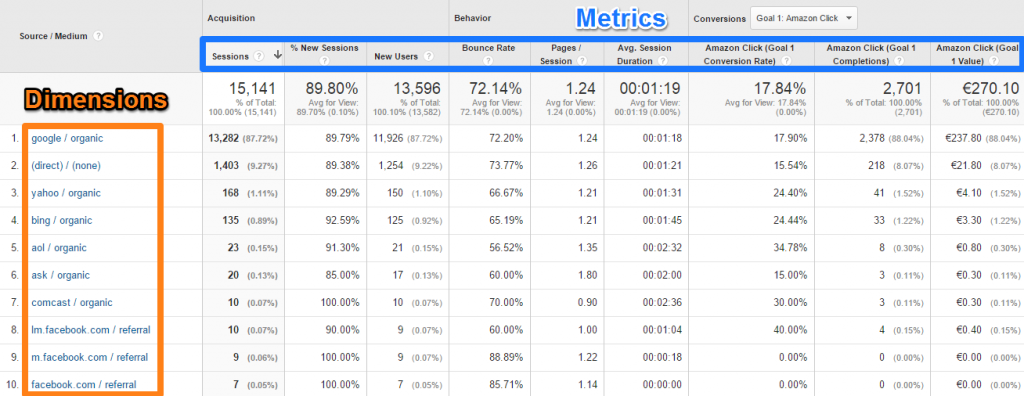Step-by-Step Guide: Leveraging Secondary Dimension in Google Analytics
Step-by-Step Guide: Leveraging Secondary Dimension in Google Analytics
Blog Article
Transform Your Analytics Technique With Second Dimension in Google Analytics
By incorporating additional dimensions right into information evaluation, a new layer of insights emerges, dropping light on elaborate user behaviors and interactions. The strategic application of secondary measurements holds the key to opening a treasure trove of important details that can transform just how services interpret and act upon their data.
Comprehending Second Dimensions in Google Analytics
Additional measurements in Google Analytics supply additional context to primary data by permitting users to evaluate metrics throughout a second dimension, supplying deeper insights right into customer behavior and interactions on an internet site. Secondary Dimension in Google Analytics. While main measurements provide fundamental data factors such as pageviews, bounce price, and session period, secondary dimensions use an even more thorough view by segmenting the primary data additionally. This division permits customers to analyze metrics in combination with another dimension, such as web traffic sources, demographics, or individual behavior
Benefits of Using Secondary Dimensions
Using additional measurements in Google Analytics supplies a strategic advantage by improving the depth of analysis and supplying a much more thorough understanding of user interactions and habits on a website. By integrating second measurements, experts can obtain valuable insights into the efficiency of certain segments or variables within their data. This allows an extra detailed evaluation of individual behavior past surface-level metrics, permitting a much deeper expedition of the variables influencing individual involvement and conversions.

How to Execute Additional Measurements
When integrating second dimensions in Google Analytics, one essential action is to select the appropriate metrics and measurements to enhance the evaluation process. To apply additional measurements efficiently, beginning by accessing your Google Analytics account and navigating to the record you want to enhance with added data. As soon as in the report, find the "Second Dimension" switch, typically found over the data table. Clicking this switch will open a drop-down menu listing numerous dimensions that can be contributed to your key dimension for much deeper insights.
After selecting the suitable additional measurement, such as 'Source/Medium' or 'Device Category,' Google Analytics will show the information in a more comprehensive style, permitting you to cross-analyze different aspects of individual actions. Remember to explore different combinations of secondary and main measurements to reveal valuable patterns and patterns that can educate your advertising and marketing methods. By implementing additional measurements thoughtfully, you can view website acquire an extra thorough understanding of your site or application efficiency and make data-driven decisions to maximize your electronic presence.
Analyzing Data With Additional Measurements
Improve your data analysis in Google Analytics by incorporating secondary dimensions to dive much deeper right into customer actions patterns and optimize your digital advertising and marketing methods successfully - Secondary Dimension in Google Analytics. By adding additional dimensions to your main information, you can obtain beneficial insights that can assist you make notified decisions regarding your internet site or app performance
Assessing information with additional measurements permits you to sector your key data further, offering a more comprehensive view of individual interactions. Incorporating the primary measurement of 'source/medium' with a second dimension like 'landing web page' can reveal which particular web pages are driving traffic from different resources. This details can be important in improving your content technique or maximizing your advertising projects to raise conversions.
Additionally, using second dimensions enables you to determine relationships between different metrics, assisting you recognize the impact of various aspects on customer actions. Whether it's analyzing demographics alongside individual interaction metrics or tool groups with conversion rates, additional measurements encourage you to uncover concealed fads and patterns that can guide your advertising efforts.
Maximizing Efficiency With Secondary Measurements
To boost the effectiveness of information evaluation and decision-making in Google Analytics, including secondary dimensions is crucial to optimizing efficiency metrics and obtaining deeper understandings right into individual actions patterns. By utilizing additional measurements, experts can delve past surface-level data and discover beneficial correlations that might you could try these out otherwise go unnoticed. This optimization method enables organizations to tailor their marketing initiatives more effectively, identify locations for enhancement in internet site usability, and boost general customer experience.
Second measurements offer a more extensive view of user interactions by offering additional context to primary information metrics. Matching the primary measurement of 'landing web page' with an additional dimension like 'tool classification' can reveal whether certain gadgets are much more likely to drive involvement on certain landing web pages. This insight can educate receptive style improvements or targeted advertising and marketing approaches to increase efficiency.

Verdict
To conclude, the combination of like this second measurements in Google Analytics gives businesses with an effective device to improve their analytics method. Secondary Dimension in Google Analytics. By delving deeper right into user behavior and interactions, marketing professionals can discover valuable understandings that can drive performance optimization and enhance the overall customer experience. Leveraging secondary measurements enables an extra extensive evaluation of data, causing more educated decision-making and customized marketing initiatives
Secondary dimensions in Google Analytics give additional context to main information by allowing customers to analyze metrics across a 2nd dimension, providing much deeper insights into individual habits and interactions on an internet site. While primary measurements give fundamental data factors such as pageviews, bounce price, and session duration, additional measurements offer an even more detailed sight by segmenting the primary data further.One of the crucial advantages of using additional dimensions is the capability to reveal relationships and patterns that may not be quickly obvious when assessing data with main measurements alone.When incorporating secondary measurements in Google Analytics, one crucial step is to choose the pertinent metrics and measurements to enrich the analysis procedure. Combining the key dimension of 'landing page' with a second measurement like 'device classification' can expose whether particular devices are more likely to drive interaction on certain touchdown pages.
Report this page